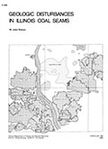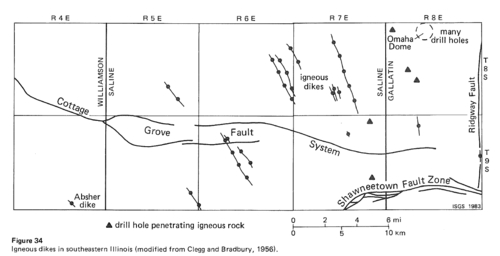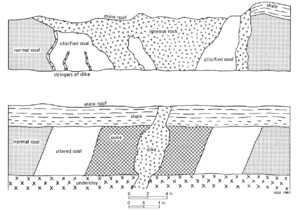Circular 530 Igneous Dikes
| Geologic Disturbances in Illinois Coal Seams | ||||||||||
|---|---|---|---|---|---|---|---|---|---|---|
| Channels | Split Coal | Rolls | Limestone Bosses | Clay Dikes | White Top | Igneous Dikes | Joints | Coal Balls | Miscellaneous Disturbances | Acknowledgments |
Igneous Dikes
Igneous dikes are vertical or steep, wall-like masses of igneous rock intruding into coal seams and other layered rocks. lgneous rock crystallized from magma-molten rock from deep within the earth. Generally it forced open faults and fractures in the earth's crust. Cooling as it rose, the magma filled these cracks/fractures and hardened into dikes.
In Saline and extreme eastern Williamson Counties, the coal-bearing strata contain igneous dikes (fig. 34). lgneous rock also appears in holes drilled in Saline and Gallatin Counties. All dikes are straight, trending in a northwesterly or north-northwesterly direction. They can be hundreds of feet to several miles long. Although most are a few feet to about 30 feet wide, one dike was reported to be 300 feet wide. Descriptions of igneous dikes are mainly from the Springfield Coal, the primary commercial seam of southeastern Illinois; but they penetrate all coal seams.
Dikes are a dark gray to black rock called mica peridotite (Clegg, 1955; Clegg and Bradbury, 1956). It is extremely hard when fresh, but weathers to a soft, crumbly rock near the surface.
Along igneous dikes, coal was commonly coked by the heat of the magma (Clegg, 1955) (fig. 35). Coked zones range from several inches to many feet wide. Generally, this coke is not useful as a fuel because of its high mineral content.
The igneous dikes of Saline and Williamson Counties occur along faults and fractures of the Cottage Grove Fault System. In many cases the coal has not only been penetrated and coked, but has also been displaced along faults offset from a few inches to many feet. More details on the Cottage Grove Fault System and its relationship to igneous dikes are published in Nelson and Krausse (1981) and Nelson (1981).
Mining problems.
Igneous rock is very difficult to cut or blast in underground workings, so dikes are usually left inside pillars. Also difficult to mine is mineralized coke-normally left in the ground along with the igneous rock.
References
- Clegg, K. E., 1955, Metamorphism of coal by peridotite dikes in southern Illinois: Illinois Geological Survey Report of Investigations 1 78, 18 p.
- Clegg, K. E., and J. C. Bradbury, 1956, Igneous intrusive rocks in Illinois and their economic significance: Illinois Geological Survey Report of Investigations 197, 19 p.
- Nelson, W. J., 1981, Faults and their effect on coal mining in Illinois: Illinois State Geological Survey Circular 523, 38 p.



